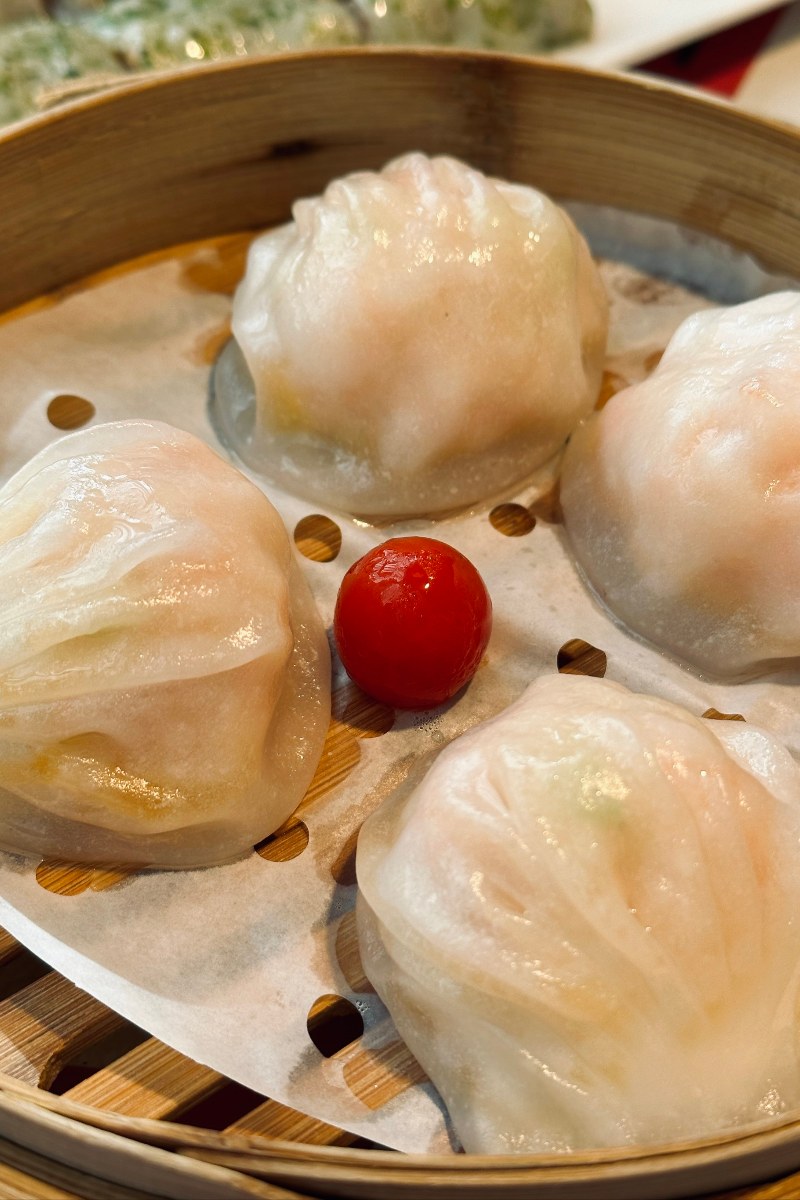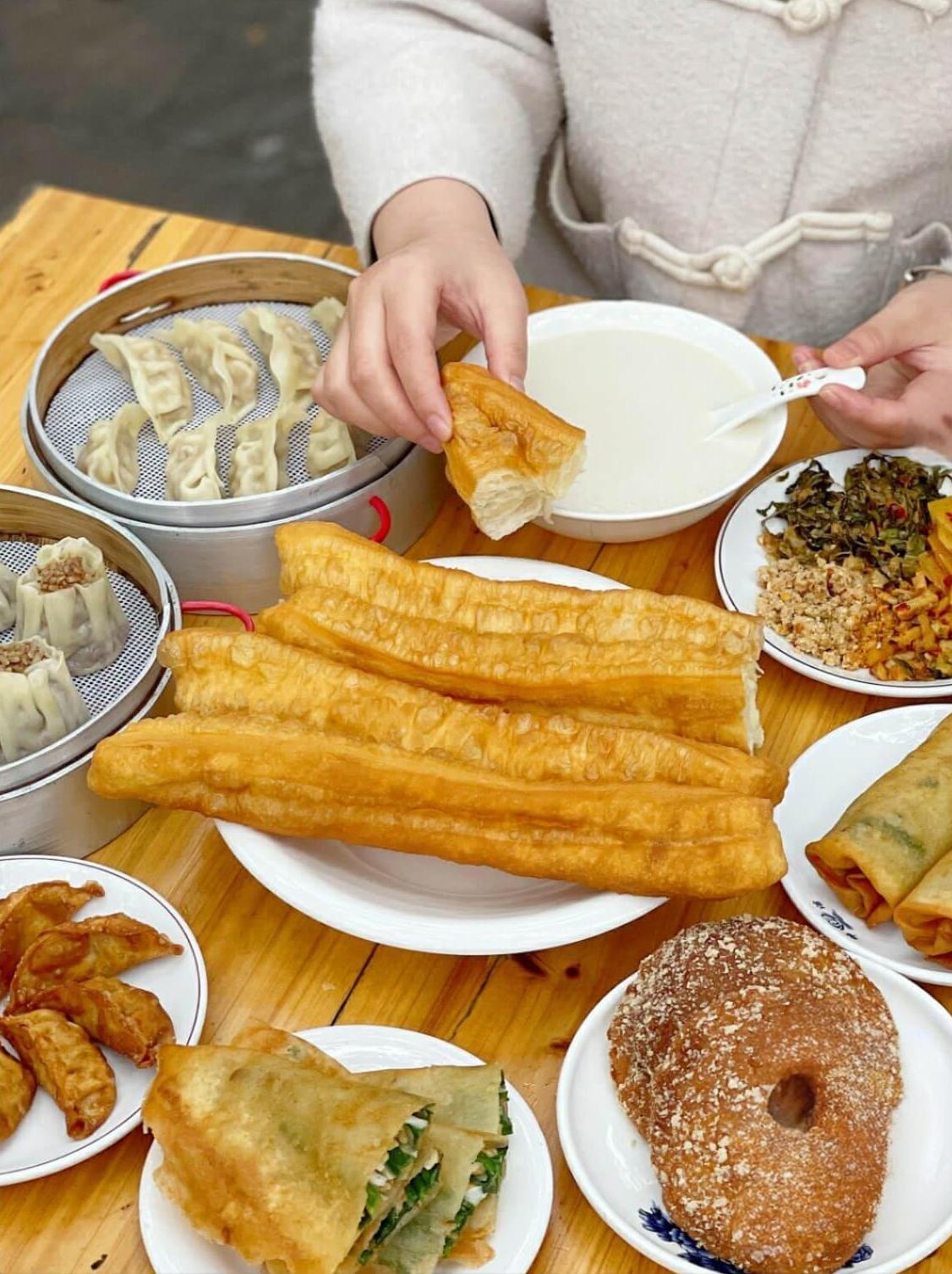The Dragon Boat Festival is more than just thrilling boat races—it’s a vibrant celebration rich in history, culture, and unique flavors. Central to this festival is the famous Dragon Boat Festival food, such as sticky rice dumplings (called zongzi) and savory tea eggs. These traditional dishes bring families and friends together, creating a strong sense of community and honoring ancient customs that have lasted over 2,000 years. During the festival, you’ll see locals carefully preparing and sharing these delicious treats, each wrapped in bamboo leaves or infused with special spices. Enjoying Dragon Boat Festival food is more than just tasting flavors—it’s about connecting with China’s deep cultural heritage. The festival’s foods tell stories of legends, family bonds, and respect for history. For travelers, sampling these iconic dishes offers a flavorful way to experience the Dragon Boat Festival and gain insight into Chinese traditions. Dive into the celebration, savor the history, and feel the warmth of this special holiday through its unique food.
What Is the Dragon Boat Festival?
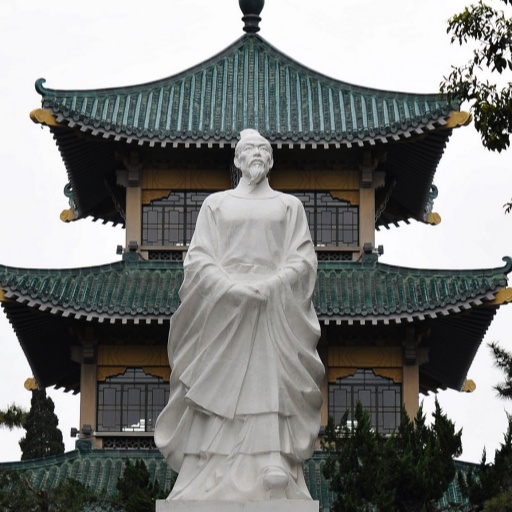
Statue of Qu Yuan
The Origins of the Dragon Boat Festival
The Dragon Boat Festival has deep roots in Chinese history. Its origin story goes back more than two thousand years. Most people connect it with one man: Qu Yuan , a famous poet and loyal minister of the Chu State during the Warring States period.
Qu Yuan wasn’t just a writer. He loved his country and fought for political reform. But the court was corrupt, and his advice was ignored. Eventually, he was exiled, forced to live far from his homeland. Even in exile, He kept writing poems filled with sorrow and hope for his people. When the Chu capital fell to enemies, he was devastated. In despair, he threw himself into the Miluo River.
The local people respected Qu Yuan deeply. When they heard he had drowned, they rushed to save him. They paddled out in boats, beating drums to scare away fish and evil spirits. They threw balls of sticky rice into the water. This way, they hoped the fish would eat the rice instead of his body. These acts are believed to be the roots of dragon boat racing and zongzi-making.
Even the timing of the festival plays a role. The fifth day of the fifth lunar month was considered unlucky in ancient China. It’s a time when diseases could spread easily. So people used this day to protect their health and homes through rituals, food, and tradition.Today, the Dragon Boat Festival is celebrated in honor of Qu Yuan, but it’s also a celebration of ancient values.
Traditional Activities During the Dragon Boat Festival
People love many activities on this special day. Dragon boat races are the highlight. And homes get special decorations too. Families hang mugwort leaves on doors and calamus stems by windows. These herbs are believed to keep germs and bad spirits away. Children wear fragrant sachets filled with herbs and spices. These colorful pouches look cute and smell nice. Everyone feels safer with these charms.
Drinking realgar wine is another tradition. This wine has a strong smell, made from minerals and rice wine. People think it drives away insects and evil spirits. Elders pour small cups for children and dab the wine on their hair. Though bitter, this ritual is fun and brings families closer.
Making and eating dragon boat festival food is very important. Zongzi is the most popular treat. People soak rice overnight, wrap it with fillings in bamboo leaves, then steam or boil them. The smell fills kitchens and warms hearts. Friends share their zongzi and compare flavors happily.
Other snacks include tea eggs cooked in spiced tea and soy sauce. Rice cakes called dagaog are made by pounding glutinous rice, cutting it into pieces, and decorating with beans or sesame seeds. Fried glutinous rice balls called jiandui puff up golden and crispy. These foods fill tables and add joy to the festival.
What Are the Traditional Dragon Boat Festival Foods?
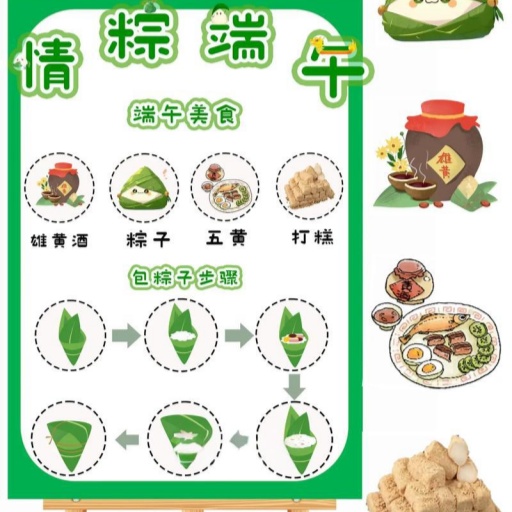
Traditional Dragon Boat Festival Foods
1.Zongzi (Sticky Rice Dumplings)
Zongzi stands as the signature dragon boat festival food. People across China wrap glutinous rice in bamboo or reed leaves. Inside, they add fillings like pork belly, red beans, salted egg yolks, or dates. The bundles are then tied with string and steamed or boiled for several hours. This ritual, rooted in ancient customs, honors Qu Yuan, the patriotic poet. Families gather to prepare and enjoy this dish together, making it a core tradition.
Over time, regional differences gave rise to many types of Zongzi. Southern variations often include savory pork and mushrooms. In contrast, northern styles favor sweet fillings like jujube paste. These wrapped dumplings aren't just delicious—they carry cultural meaning. They represent respect for heritage and hope for good fortune.
Even today, people wait eagerly for Zongzi season. The aroma of bamboo leaves and sticky rice fills homes and markets. This time-honored snack, among the most iconic dragon boat festival dishes, keeps evolving but always connects back to its roots.
2.Realgar Wine (Xionghuang Jiu)
Realgar wine plays a special role in Dragon Boat Festival traditions. Made from fermented rice and realgar powder, it was once thought to ward off evil. Parents dab a bit behind their children’s ears or on the forehead. In ancient times, people believed it protected against disease and insects during summer. Though less common today, it still symbolizes safety and health.
The flavor of realgar wine is strong and earthy. It’s not a casual drink, but many elders insist on a sip during the holiday. Drinking it is more about tradition than taste. Some families make small toasts, believing the wine brings peace for the year. Others include it in rituals, honoring past generations.
Even though modern science questions its benefits, the ritual endures. Among dragon boat festival foods and drinks, this wine carries deep symbolism. It reflects a blend of ancient beliefs, seasonal change, and community customs that define the festival.
3.Rice Cake (Dagaog)
Rice cakes, known as Dagaog in some regions, offer a chewy treat. People pound glutinous rice until smooth, then shape it into disks. Sometimes they add sweet bean paste or sesame inside. This dragon boat festival food is simple but satisfying. It sticks to tradition, both in flavor and texture.
Communities often hold pounding events during the festival. Neighbors gather around, taking turns with wooden mallets. The sound of pounding echoes through village squares. This group effort isn’t just for making food—it strengthens community ties. Sharing Dagaog afterward celebrates unity and effort.
Though fewer families make it by hand today, the dish remains popular. Stores offer premade versions with modern twists like matcha or chocolate. Still, its heart stays the same. Among dragon boat festival treats, Dagaog connects old techniques with modern tastes.
4.Tea Eggs
Tea eggs bring elegance to the festival menu. They’re hard-boiled eggs steeped in a fragrant brew of tea, soy sauce, and spices. The marbled look makes them eye-catching, while the taste is subtle and savory.People simmer eggs for hours, allowing flavor to seep through. Popular spices include star anise, cinnamon, and Sichuan peppercorn. The longer they soak, the richer the taste.As part of dragon boat festival food, tea eggs offer a quick snack packed with tradition. They’re easy to make, flavorful, and carry a sense of calm ritual. Whether served hot or cold, they add balance to the holiday spread.
5.Fried Glutinous Rice Balls (Jiandui)
Jiandui are crispy on the outside and chewy inside. These sesame-coated rice balls are deep-fried until golden brown. Fillings vary—lotus paste, red bean, or black sesame.Making them takes care. You roll glutinous rice dough into balls, fill them, coat them with sesame, and fry. The result is a sweet, aromatic bite that delights all ages.These golden treats symbolize happiness and fortune. Among dragon boat festival foods, they’re festive and satisfying. Jiandui combines texture, taste, and meaning in every crunchy bite.
What Are the Different Types of Zongzi Across China?

Different Flavored Zongzi
Northern-Style Zongzi: Sweet and Simple
Northern-style zongzi are light and sweet. Common fillings include red bean paste, jujube, or just plain glutinous rice. They’re small, cone-shaped, and easy to carry. The flavor is mild, which makes them popular with kids and elders. The aroma of bamboo leaves adds a nice touch. These dumplings reflect the northern preference for clean, simple tastes.
They're also easy to make. Rice is soaked overnight, and fillings need little prep. Wrapping is less tricky than the southern version. After wrapping, they’re boiled or steamed for hours. These zongzi are more than a snack—they connect people to old customs and family memories.
This type of zongzi is especially popular in Beijing, Tianjin, Hebei, and Shanxi. If you visit during the Dragon Boat Festival, you can join zongzi-making workshops in hutongs or parks, watch dragon boat races on city lakes, and even visit folk museums for festive performances.
Southern-Style Zongzi: Savory and Rich
Southern-style zongzi are bold and filling. They're stuffed with pork belly, salted egg yolk, mushrooms, or chestnuts. Some versions add shrimp or mung beans. The rice is often stir-fried first. These dumplings are big and packed like a meal. They show the southern love for rich flavors and variety.
Making them takes time. Ingredients are soaked, marinated, and sometimes cooked in advance. Wrapping is a family tradition, with skills passed down through generations. These zongzi turn a simple festival into a feast.
They’re most popular in Guangzhou, Fujian, Zhejiang, and Jiangxi. Tourists visiting places like Guangzhou or Hangzhou can join local families for cooking sessions, see traditional dragon boat races, or explore riverside temples filled with festival decorations.
Medicinal Zongzi: Healing Through Tradition
Medicinal zongzi focus on wellness. They use herbs like mugwort, lotus seeds, goji berries, and ginseng. The rice may be soaked in herbal tea. These dumplings have earthy or bittersweet flavors. Each ingredient supports health, based on traditional Chinese medicine. They’re steamed slowly to keep their benefits.
Usually made at home by elders, these zongzi are meant for those needing a health boost. They blend food with care, protection, and healing during seasonal change.
They’re common in parts of Sichuan, Hunan, and regions with strong TCM traditions like Anhui. If you visit during the festival, you might find herbal zongzi in wellness-themed events, tea houses offering seasonal brews, or cultural centers where you can learn about TCM and festival customs together.
How Can You Make Dragon Boat Festival Dishes at Home?
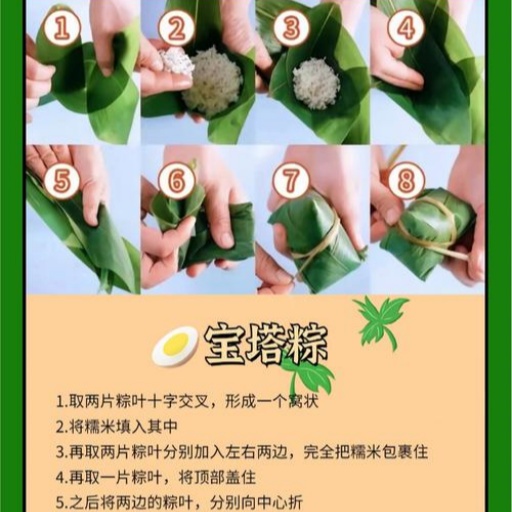
Wrapping Method for Pagoda-Shaped Zongzi
Homemade Zongzi
Making Zongzi at home brings family members together. Start by soaking glutinous rice overnight. Then wash bamboo leaves and prepare fillings like pork, beans, or dates. Wrap the rice and filling in the leaf, fold carefully, and tie with kitchen twine. Finally, steam or boil for several hours. Though time-consuming, the result is rewarding and full of flavor.
Each household adds a personal twist to their Zongzi. Some prefer savory pork belly with soy sauce. Others enjoy sweet red bean or date fillings. Spices, sauces, and rice textures vary across regions and families. This variety keeps the dragon boat festival food tradition exciting and full of stories. Cooking Zongzi becomes both a recipe and a cultural lesson.
Home-cooked Zongzi connects people to heritage. Children learn from elders how to fold and tie the dumplings. The scent of bamboo leaves fills the kitchen. Sharing them strengthens family bonds. More than just a meal, homemade Zongzi reflects love, care, and tradition wrapped into one delicious parcel.
Brewing Realgar Wine
Realgar wine plays a special role in dragon boat festival food traditions..Today, most avoid using realgar powder because of health concerns. Instead, people infuse yellow rice wine with herbs like chrysanthemum, cinnamon, and mugwort. This keeps the tradition alive without the risks. The result is a symbolic drink with earthy notes and summer vibes.
Start with good-quality yellow wine. Rinse and dry the herbs, then let them soak in the wine for a few days. Store it in a cool, dark place. Strain before drinking. This method creates a festive beverage with a nod to ancient customs. Though it won’t repel evil spirits, it honors dragon boat festival traditions in a modern way.
At home, sharing herbal wine offers a fun ritual. You can serve small glasses during meals or give it as gifts. It’s less about the alcohol and more about meaning. Among dragon boat festival foods and drinks, this version of realgar wine combines safety, culture, and creativity.
Making Dagaog (Pounded Rice Cake)
To make Dagaog at home, start with glutinous rice. Soak it overnight and steam until soft. Then use a wooden mallet or food processor to pound it into a smooth paste. Shape the mixture into discs and fill with sweet bean paste or sesame. Dust with flour or coconut before serving.
This sticky rice cake requires patience and teamwork. Traditionally, families pounded the rice together outdoors. Now, kitchen tools make it easier. The process still brings joy and a sense of tradition. It turns simple ingredients into a chewy, satisfying treat with deep roots in dragon boat festival food culture.
Homemade Dagaog tastes better than store-bought versions. You can adjust the sweetness, fillings, and texture. Kids love shaping the dough, while elders share stories of past festivals. Making Dagaog isn't just cooking—it’s preserving memories and passing down joy through generations.
Preparing Tea Eggs
Tea eggs are simple to make but full of flavor. Start by boiling eggs, then gently crack the shells. Simmer them in a broth of tea, soy sauce, star anise, cinnamon, and other spices. The cracked shells create beautiful marbled patterns. Let them steep for hours or overnight for a richer taste.
These savory snacks often appear during the Dragon Boat Festival. Their aroma blends well with other dishes like Zongzi. The dark broth gives the eggs a deep color and umami punch. They're easy to transport, store well, and make great picnic or festival treats. People of all ages enjoy their satisfying taste.
At home, making tea eggs can become a family tradition. Kids love the crackled look, and adults enjoy the bold flavor. You can experiment with different teas or spices. As part of dragon boat festival food, tea eggs offer a quick snack packed with tradition. They’re easy to make, flavorful, and carry a sense of calm ritual. Whether served hot or cold, they add balance to the holiday spread.
Frying Jiandui (Fried Glutinous Rice Balls)
Jiandui, or sesame rice balls, bring a crispy finish to any festival meal. First, mix glutinous rice flour with water into dough. Shape into balls and fill with red bean paste or sweet lotus seed paste. Roll them in sesame seeds and deep-fry until golden and puffed.
Making Jiandui at home is fun and rewarding. Watch them float and expand in hot oil—it’s quite a show! Their crispy shell and gooey center please both kids and adults. This treat balances sweetness and texture perfectly. As a classic dragon boat festival food, Jiandui adds joy and indulgence to the table.
These sesame balls represent luck and reunion. Their round shape symbolizes unity. Sharing them with family or neighbors spreads cheer. Homemade Jiandui blends tradition with delight, making each bite part of the celebration’s spirit and warmth.
How to Buy Zongzi or Its Ingredients for the Dragon Boat Festival?
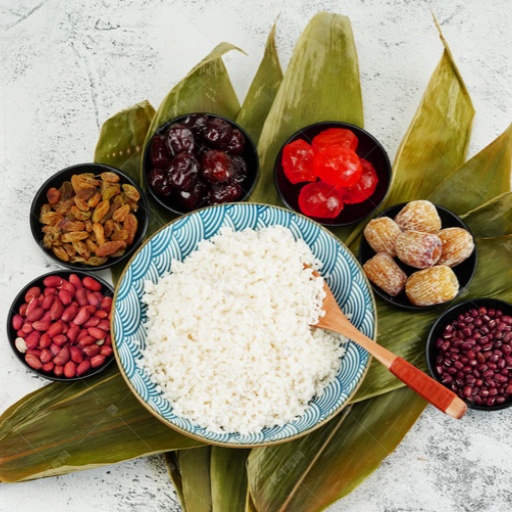
Ingredients for Making Zongzi
Find Zongzi and Ingredients at Local Asian Supermarkets
In many countries with Chinese communities, Asian supermarkets are your best bet for finding zongzi during the Dragon Boat Festival. These stores often start stocking frozen or freshly made zongzi a few weeks before the holiday, usually in May or June. Look for them in the freezer section or near the deli counter. You’ll likely find both sweet and savory versions—some filled with red bean paste or jujube, others stuffed with marinated pork, salted egg yolk, or chestnuts. Labels are often bilingual (Chinese and English), making it easier to choose based on your taste preference.
Beyond ready-to-eat zongzi, these supermarkets usually carry all the essential ingredients if you want to make them yourself. Look for glutinous rice (also called sticky rice), dried bamboo or reed leaves, and fillings like red beans, peanuts, mung beans, or preserved meats. Some stores even offer vacuum-sealed or frozen salted duck egg yolks and pre-marinated pork belly for convenience.
Staff members in these markets are usually familiar with the holiday and may help you find what you need. You might also spot special promotional displays during the festival season. If you’re new to Asian grocery stores, try asking for help at the customer service desk.
Order Zongzi or Supplies Online
If there are no nearby Asian supermarkets, don’t worry—you can still get zongzi or the ingredients online. Many e-commerce platforms now cater to international customers who want access to Asian foods. In the U.S., websites like Yamibuy, Weee!, and AsianMart offer a wide selection of frozen zongzi, bamboo leaves, glutinous rice, and even DIY zongzi kits. These kits are especially useful for beginners as they include rice, leaves, and pre-packaged fillings.
Major platforms like Amazon also carry zongzi and related ingredients. You can search for “zongzi,” “bamboo leaf rice dumplings,” or “sticky rice dumplings.” Pay attention to the product descriptions and customer reviews to ensure quality and authenticity.
Shipping times vary, so it’s a good idea to order at least two weeks before the Dragon Boat Festival. Some vendors offer express delivery during the holiday season. In some countries, you can also find zongzi on local e-commerce platforms like Shopee (Southeast Asia), Tmall Global, or RedMart (Singapore).
The main advantage of buying online is convenience and variety. You can compare flavors, prices, and brands all in one place. Many websites even offer step-by-step videos and customer reviews, making it easy to understand what you're buying—especially helpful for those new to zongzi.
Join Local Dragon Boat Festival Events for Fresh Zongzi and Culture
One of the best ways to enjoy authentic zongzi while living abroad is by attending local Dragon Boat Festival celebrations. In many cities—especially those with Chinatown districts or Chinese cultural centers—you’ll find public events in parks, riverside areas, or community halls. These festivals often feature dragon boat races, traditional music and dance performances, and most importantly, food stalls selling freshly made zongzi.
These events are usually held on the weekend closest to the fifth day of the fifth lunar month (around late May or June). You can enjoy a hot, fragrant zongzi while watching dragon boats race by, which makes for an unforgettable experience. Some events also include zongzi-making workshops, where volunteers teach visitors how to wrap rice and fillings in bamboo leaves. It’s a fun, hands-on way to learn about Chinese tradition.
To find these events, check with local Chinese associations, Confucius Institutes, universities with Chinese departments, or cultural exchange organizations. They often post event details on social media or community bulletin boards.
Participating in a festival not only lets you taste freshly made zongzi, but also brings you closer to the meaning behind the tradition. It’s a chance to connect with the local Chinese community and experience a part of Chinese heritage in a lively and welcoming setting.
Reference
Frequently Asked Questions (FAQs)
Q:Why do people eat zongzi on Dragon Boat Festival?
A:People eat zongzi to honor Qu Yuan. He was a patriotic Chinese poet. He drowned himself in the Miluo River. Locals admired his loyalty and mourned his death. They tossed rice into the river to feed his spirit. Later, they wrapped the rice in leaves. This act became a tradition. Over time, people began eating zongzi every year. The custom remains strong today.The Dragon Boat Festival celebrates Qu Yuan’s sacrifice. Eating zongzi symbolizes remembrance and national pride. People use bamboo or reed leaves to wrap sticky rice. They often add fillings like pork, egg yolk, or beans. Different regions offer different flavors. This reflects China’s rich culinary diversity.Families gather and prepare zongzi together. They boil or steam the sticky packages. The process strengthens family bonds. Zongzi also carry cultural values and stories. They connect people with history and heritage.
Q: What should I eat before Dragon Boat Festival?
A:Before the Dragon Boat Festival, eat light and balanced meals. Traditional customs suggest cleansing the body. People prefer simple dishes with herbs and seasonal vegetables. These help with digestion and health. Avoid greasy or heavy food during this time.Green vegetables are a great choice. They cool the body and nourish blood. Bitter melon is another seasonal vegetable. It helps reduce summer heat and boosts appetite. Try some mung bean soup as well. It’s cooling and refreshing.Some people also drink realgar wine. They believe it wards off evil spirits. Others use it as a preventive health drink. However, avoid alcohol if you’re sensitive to it. Ginger soup is a milder option. It warms the stomach and boosts immunity.Light porridge is also a common dish. It’s easy to digest and comforting. You can add red dates or lotus seeds. These ingredients promote energy and peace. Eating like this prepares the body well. It helps you enjoy the heavier zongzi later.So, eat wisely before the festival. Your stomach will thank you.
Q: Can I eat zongzi in China outside the Dragon Boat Festival?
A:Yes, you absolutely can eat zongzi anytime. Although tied to the festival, zongzi are available year-round. Many supermarkets stock frozen zongzi in all seasons. You’ll also find them in street stalls or restaurants.Some people enjoy zongzi for breakfast. Others eat them as snacks or lunch. They’re easy to heat and eat. The flavors range from savory to sweet. That gives you plenty of options daily.Local shops offer regional flavors too. Some even sell mini zongzi for convenience. Online platforms also deliver fresh or frozen varieties. So, access is never a problem. Outside the festival, zongzi remain part of daily life.Families may cook zongzi for special occasions. Some people make them during gatherings. Others just enjoy their nostalgic taste. Grandparents may use family recipes year-round. These keep old traditions alive beyond the festival.So yes, go ahead and eat zongzi anytime. They’re tasty, symbolic, and convenient. Dragon Boat Festival may be the highlight, but the flavor lasts longer.
Q: Can children eat all types of Dragon Boat Festival food?
A:Not all Dragon Boat Festival food suits children. You should choose their dishes carefully. Zongzi come in many types, some too rich for kids. For example, fatty pork or salted egg yolk may upset their stomachs.Children’s digestive systems are still developing. Heavy or oily fillings can cause discomfort. Instead, choose sweet zongzi with red bean or dates. These are softer, milder, and easier to digest.Also, check the leaf wrapping carefully. Sometimes, kids accidentally eat parts of it. Always remove the leaf and slice the zongzi. It makes eating safer and easier.Avoid realgar wine for children. Traditionally used during the festival, it's not safe for kids. Instead, offer herbal teas like chrysanthemum. These are calming and caffeine-free.Some festive snacks contain allergens like peanuts. Read labels or ask vendors when in doubt. Go for homemade versions if possible. You can control the ingredients and reduce risks.So yes, children can enjoy festival food. But pick age-appropriate types. Focus on nutrition and digestion. That way, they stay healthy and festive.
Q: Are there any unusual or rare zongzi flavors to try?
A:Yes, China offers many rare zongzi flavors. Some will really surprise you. Beyond traditional pork or beans, modern chefs experiment with ingredients. This makes zongzi more exciting and creative.In Shanghai, try zongzi filled with ham and rose petals. It’s both salty and floral. In Yunnan, people add mushrooms and preserved meats. These zongzi carry a deep, earthy flavor. In Fujian, seafood zongzi are popular. They include dried scallops or shrimp.Dessert lovers can try chocolate or matcha zongzi. Some shops even offer custard or cream cheese fillings. These blend East and West beautifully. There are also vegetarian versions with nuts and wild herbs. Some include pickled vegetables or sweet potato.Unusual shapes also exist. Some zongzi are pyramid-shaped. Others look like small pillows or rectangles. Some are tiny and bite-sized for quick snacks.During Dragon Boat Festival, creative shops release limited editions. These sell out fast due to demand. So try them if you get the chance. Every bite tells a unique story.So yes, rare zongzi are worth trying. They reveal regional tastes and culinary imagination.
Q: How long can zongzi be stored after cooking?
A:Cooked zongzi can last a few days with care. If left at room temperature, eat them within 12 hours. They spoil quickly in summer heat. Always check the smell and texture before eating.For better storage, refrigerate cooked zongzi. They last up to 3 days there. Use airtight containers to reduce moisture and smell. If you want longer storage, freeze them.In the freezer, zongzi can last 1 to 2 months. Wrap them in plastic first. Then store them in a sealed bag. Label the date to track freshness. Reheat frozen zongzi by steaming. Avoid microwaving directly—it dries them out.Also, don’t refreeze zongzi after thawing. That causes texture loss and spoiling. Homemade zongzi with no preservatives go bad faster. Store-bought ones may last longer due to added ingredients.So yes, zongzi last well with care. Just store and reheat them properly. That way, you can enjoy them safely even after the festival.
Q: Can I make zongzi without bamboo or reed leaves?
A:Yes, you can make zongzi without bamboo or reed leaves. But the taste will change. The leaves add aroma and structure. Without them, you’ll need substitutes.Banana leaves are a common alternative. They’re large, flexible, and add mild fragrance. Corn husks can work too. They're firm but lack the traditional flavor. Some people use lotus leaves, though they’re harder to find.If you can’t find any leaves, try silicone molds. Line them with parchment paper first. This keeps the rice from sticking. However, the texture may differ slightly.Another option is to steam sticky rice in a wrapped cloth. It won’t form the same shape, but still tastes good. Focus on the fillings and seasonings for flavor.These methods are great for people abroad. They allow zongzi-making without hard-to-find leaves. So yes, you can still enjoy homemade zongzi.Just manage your expectations. The flavor won’t be fully traditional. But the heart of the dish remains. It’s about sharing and celebration.
Q: How is zongzi different from Japanese rice balls or sushi?
A:Zongzi, Japanese rice balls, and sushi are all rice-based. But they differ greatly. Their ingredients, preparation, and meanings are unique.Zongzi uses glutinous rice. It’s soaked, filled, and wrapped in leaves. Then it’s steamed or boiled. The fillings can be sweet or savory. They often include meats, beans, or nuts. Zongzi are soft, sticky, and dense.Japanese rice balls—onigiri—use regular rice. They’re shaped by hand and often wrapped in seaweed. Fillings include pickled plum, fish, or miso. Onigiri are dry and portable.Sushi also uses regular rice, seasoned with vinegar. It’s rolled or shaped with raw or cooked seafood. Sushi has a delicate texture and fresh taste. It’s often served cold with soy sauce and wasabi.Zongzi are eaten during a festival. They symbolize tradition and history. Onigiri and sushi are everyday foods. They’re more about convenience and freshness.So yes, zongzi are quite different. The ingredients, method, and purpose vary. Each food reflects its cultural roots. They all celebrate rice, but in unique ways.
